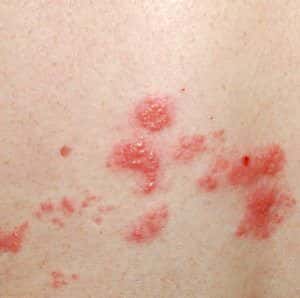
It’s an odd name for a nasty condition: shingles. It has nothing to do with roofing. The Latin name, cingulum, meaning “belt,” became “shingles” in early English. The Latin name is a reference to the strips of rash on one side of the body.
Shingles is a painful skin condition that can develop in anyone who has had chickenpox. The virus that causes chickenpox, Varicella zoster virus (VZV), is a member of the herpes family. It goes into hiding when a person recovers from chickenpox, but many years later if age, illness or stress weakens the immune system, VZV can reappear. It causes extreme tenderness along the path of the affected nerve. Within a few days, a blistering rash appears.
Shingles usually attacks older people, but even individuals in their 40s may suffer. Prescription anti-viral drugs such as acyclovir (Zovirax), famciclovir (Famvir) or valacyclovir (Valtrex) can shorten the duration and intensity of the attack. These drugs are most effective if taken within a few days of the initial symptoms.
There is now a shingles vaccine, Zostavax, that halves the chance of coming down with shingles. It also seems to reduce the severity of the attacks that occur.
Some people have wondered if they should get vaccinated after they have had shingles. One reader wrote:
“I had shingles many years ago. So did my friend. Her doctor gave her a shingles shot so she won’t get it again. My doctor said by having shingles I built antibodies to it and don’t need the shot. Which doctor is correct?”
Data just published in the Mayo Clinic Proceedings (February, 2011) show that people can get shingles more than once. As a result, it makes sense to get vaccinated even after having shingles. People are urged to get the shot after they turn 60 and not to wait until they are debilitated. The shot is considered much less reliable if the immune system is weakened.
People with shingles are often desperate, like this reader:
“I have recently had an outbreak of shingles, even though I had the vaccine last year. This is the sixth week of constant burning pain with the rash gradually fading. It covers the right side of my chest, shoulder and back of neck.
“The doctor gave me Vicodin and lidocaine patches for the pain. Is there anything natural that I could take for this nerve pain?”
Readers of this column have offered several suggestions. One person took L-lysine twice a day, on the theory that it helps heal cold sores (caused by a different herpes virus). She reported: “I didn’t have all the after-pain and the rash disappeared fast.” Another reader reported success from adenosine monophosphate injections, based on decades-old preliminary research (Journal of the American Medical Association, March 8, 1985).
One popular home remedy for shingles pain is Listerine:
“An unemployed friend without health insurance had an outbreak of shingles on the right side of his face. It made his ear and jaw ache and the rash was becoming raw. I found a brief mention of using Listerine on shingles, and he tried it. After 72 hours of thrice daily application of Listerine, the sores have dried up and are scabbing over, his pain is almost gone and he is healing nicely.”
Home remedies remain untested, so preventing an outbreak is best. The vaccine offers that possibility.

